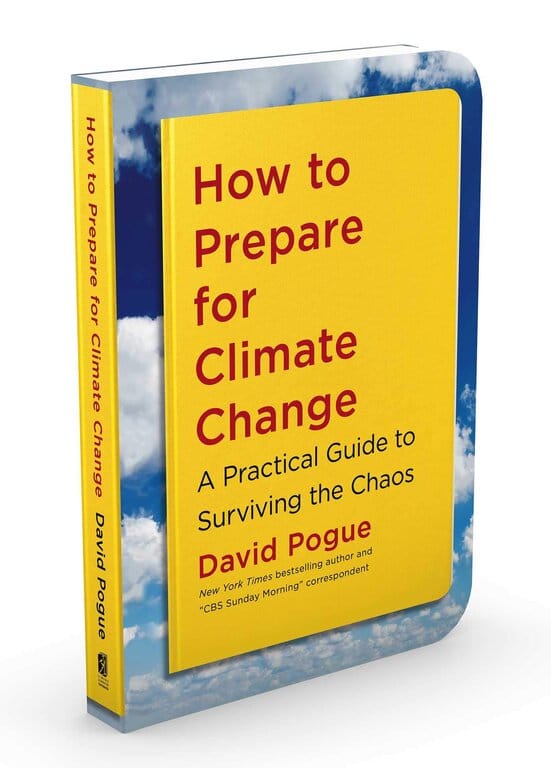Amid the ongoing debates regarding governments and private corporations’ responsibilities in climate change, one thing is certain: the climate crisis is a multifaceted issue with human activities being the main driver. Aside from institutional and market reforms, individual contribution can make a huge difference in addressing the climate emergency. But this raises a question: what specific action do we need to take? David Pogue, notable American tech columnist, writer and TV presenter, offers a comprehensive list of adaptation strategies in his latest book, How to Prepare for Climate Change: A Practical Guide to Surviving the Chaos.
—
With a refreshing lack of scepticism and offering endless discussions on whom to blame, David Pogue takes a more direct route by calling for immediate action on an individual level to deal with the climate chaos. Since the planet started to warm up 150 years ago upon the commencement of the Industrial Revolution, we are damaging the planet to the point it cannot be reset even if we stopped burning fossil fuels and deforestation. We have reached a deadlock in which humanity can barely do anything to stop the irreversible effects of climate change.
Does this really mean we are simply sitting ducks, waiting for the end of the world to arrive? To this, David vehemently disagrees. Instead, he sheds light on a more proactive approach in which humans should adopt to combat climate change and to minimise the potential catastrophic effects that threaten the survival of future generations. Taking inspiration from John Holdren, a Harvard energy expert and climate advisor to former US President Barack Obama, we basically have three choices on climate change: mitigation, adaptation and suffering. For David, he believes climate adaptation to be highly important as it allows us to develop coping strategies to make us strong enough to weather through the menaces we are going to face.
The book starts off with recommending actions we can take, from macro to micro level, and ways to address eco-anxiety. Here, David reminds us that we always have the right and ability to reach out to governments and influence groups to voice our opinions and concerns. On a personal level, the author emphasises the importance of mental health in order to be prepared for the road ahead, advising techniques on how to manage stress and feelings of despair in the face of the climate crisis. Doing exercise, exposing oneself to nature, and deep breathing are effective stress relief strategies. If all these fail, we should revert to individual therapy or group therapy.
The subtitle of the book suggests that the author is addressing climate change in a practical sense that even climate change deniers or those who refute the claim that human activity is the root cause can find value in. In fact, David dedicates an entire chapter on Where to Live and discusses the pressing problem of climate migration, as more and more places are subject to floods or extreme weather conditions. What can be worse than being forced to relocate and the subsequent uncertainty of settling in a new location and the stress of the hefty relocation expenses? Instead of moving endlessly, David introduces a radical idea of constructing resilient buildings with energy backups, drought protection, and flood-resistance facilities. Such a proposal is justifiable from a cost-and-benefit analysis, as the durability of the asset means that it can be inherited by your descendants and future generations. He also dives deep into every aspect of life and provides a survival manual that prepares people for any foreseeable circumstances including drought, food shortage, wildfires, hurricanes, tornadoes, civil unrest, and even mosquitoes and ticks.
You might also like Earth.Org’s review of Sentient by Jackie Higgins
Climate despair is unquestionably a growing phenomena, but does it mean we should lose faith in solving the climate crisis? David is steadfastly optimistic about our chances and offers a range of reasons to it. In the concluding chapter Where to Find Hope, he states that an overwhelming number of governmental bodies and organisations are doing extraordinary things to mitigate the crisis. For instance, the Paris Agreement legally binds 195 countries in setting long-term goals in reducing global greenhouse gas emissions. Multinational corporations are taking serious measures in reducing the emission of carbon dioxide and reverting to renewable energy. Many big idea solutions have emerged in recent years such as putting a price on carbon, designing safer nuclear power, inventing carbon removal technology, and reverting to geo-engineering. Yes, the world at large has had a late start in protecting our environment. Nevertheless, in detailing all the horrifying consequences and possible adaptation and solutions throughout his book, David hopes we can get ourselves well-prepared to protect ourselves and our future generations.
David plays the dual role of the author and the reader, which makes for a more powerful and convincing read. This persuasive yet personal style of writing successfully builds an emotional connection with the audience. As a responsible member of this planet, and as a father to three, he understands acutely the negative impacts and the fears brought about by climate change, just like us. But with this book, and its comprehensive list of doable and pragmatic action items that require an overhaul in our current lifestyle, it is not too late to start now. If every individual on this planet picks one suggestion recommended by David, commits and adheres to the transition, this aggregate effort can certainly help to mitigate the global issue of global warming, and bring hope not only to human beings, but other species on Earth.
Check out Earth.Org’s fascinating video conversation with David here.
How to Prepare for Climate Change: A Practical Guide to Surviving the Chaos
David Pogue
2021, Simon & Schuster, 624pp


















